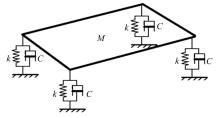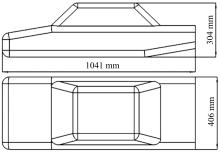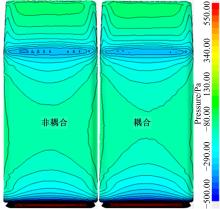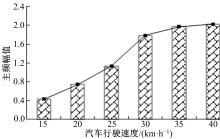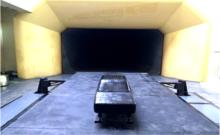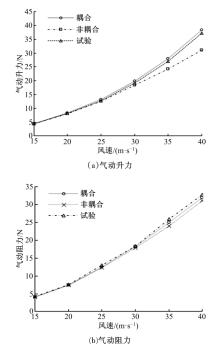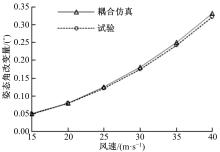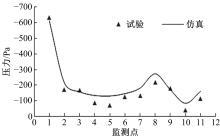吉林大学学报(工学版) ›› 2019, Vol. 49 ›› Issue (5): 1414-1419.doi: 10.13229/j.cnki.jdxbgxb20180145
• • 上一篇
基于流固耦合的汽车气动特性
- 吉林大学 汽车仿真与控制国家重点实验室,长春 130022
Characteristics of aerodynamics for an automobile by fluid-structure coupled method
Xing-jun HU( ),Zheng HUI,Peng GUO,Yang-hui ZHANG,Jing-long ZHANG,Jing-yu WANG(
),Zheng HUI,Peng GUO,Yang-hui ZHANG,Jing-long ZHANG,Jing-yu WANG( ),Fei LIU
),Fei LIU
- State Key Laboratory of Automotive Simulation and Control, Jilin University, Changchun 130022, China
摘要:
传统CFD仿真方法通常只考虑风载荷对汽车气动性能的作用,忽略了车身结构振动与气流之间耦合作用带来的影响,导致计算结果与真实汽车行驶状况存在一定偏差。以1/4标准MIRA模型为研究对象,通过双向显式流固耦合仿真方法将流固耦合效应引入到数值计算中,得到不同工况下的气动力、表面压力、振动频率以及车身姿态角等数据,分析与传统仿真方法在计算结果上的差异,再利用风洞测试技术验证仿真结果的准确性。对比有无耦合仿真及试验结果表明:耦合仿真与试验结果更加吻合,各项数据偏差都在5%以内,从而验证了耦合仿真方法的准确性;随车速增加流固耦合效应影响增大,特别是对气动升力的影响较大,直接影响汽车操纵稳定性,因此在高速时流固耦合效应带来的影响不能忽略。
中图分类号:
- U461.1
| 1 | 胡兴军. 汽车空气动力学[M]. 北京: 人民交通出版社, 2014. |
| 2 | 朱文峰, 林佩剑, 周辉. 高速流固耦合效应下车窗密封机理建模与分析[J]. 汽车工程, 2015, 37(12): 1395-1399. |
| ZhuWen-feng, LinPei-jian, ZhouHui. Modeling and analysis of window sealing mechanism of high speed fluid-solid coupling effect[J]. Automotive Engineering, 2015, 37(12): 1395-1399. | |
| 3 | 李田. 高速列车流固耦合计算方法及动力学性能研究[D]. 成都: 西南交通大学牵引动力国家重点实验室, 2012. |
| LiTian. Study on fluid-structure coupling calculation method and dynamics performance of high speed train[D]. Chengdu: State Key Laboratory of Traction Power, Southwest Jiaotong University, 2012. | |
| 4 | CaiC S, ZhangW, LiuX Z, et al. Framework of wind-vehicle-bridge interaction analysis and its applications[J]. Journal of Earthquake and Tsunami, 2013, 7(3): 132-141. |
| 5 | 谢超, 谷正气, 宗轶琦, 等. 流固耦合作用对汽车侧窗气动噪声的影响[J]. 中国机械工程, 2014, 25(24): 3391-3396. |
| XieChao, GuZheng-qi, ZongYi-qi, et al. Influence of solid coupling on aerodynamic noise of automobile side window[J]. China Mechanical Engineering, 2014, 25(24): 3391-3396. | |
| 6 | 朱晖, 杨志刚. 类车体流固耦合现象实验及数值分析[J]. 同济大学学报: 自然科学版, 2014, 42(11): 1694-1699. |
| ZhuHui, YangZhi-gang. Experimental and numerical analysis for fluid structure interaction phenomenon of ahmed body[J]. Journal of Tongji University (Natural Science), 2014, 42(11): 1694-1699. | |
| 7 | 钱若军, 董石麟, 袁行飞. 流固耦合理论研究进展[J]. 空间结构, 2008, 14(1): 3-15. |
| QianRuo-jun, DongShi-lin, YuanXing-fei. Research progress in fluid-solid coupling theory[J]. Spatial structure, 2008, 14(1): 3-15. | |
| 8 | 苏波, 钱若军, 袁行飞. 流固耦合界面信息传递理论和方法研究进展[J]. 空间结构, 2010, 16(1): 3-10. |
| SuBo, QianRuo-jun, YuanXing-fei. Advabces in researchon theory and method of data exchange on coupling interface for FSI analysis[J]. Spatial structure, 2010, 16(1): 3-10. | |
| 9 | SAE J2071—1994. Aerodynamic testing of road vehicles-open throat wind tunnel adjustment[S]. |
| 10 | 杨博, 傅立敏. 轿车外流场网格生成策略及数值模拟[J]. 农业机械学报, 2007, 38(4): 8-11. |
| YangBo, FuLi-min. Mesh generation strategies of the external flow field around a sedan and the numerical simulation research[J]. Journal of Agricultural Mechanization, 2007, 38(4): 8-11. | |
| 11 | SimoneS. Numerical flow simulations of a detailed car underbody[C]∥SAE Technical Paper, 2001-01-0703. |
| 12 | 康顺. 计算域选取对CFD模拟结果的影响[C]∥中国工程热物理学会2004年热机气动热力学学术会议论文集, 西安, 2004: 128-133. |
| 13 | SongK S, KangS O, JunS O, et al. Aerodynamic design optimization of rear body shapes of a sedan for drag reduction[J]. International Journal of Automotive Technology, 2012, 13(6): 905-914. |
| 14 | KangS O, JunS O, ParkH I, et al. Actively translating a rear diffuser device for the aerodynamic drag reduction of a passenger car[J]. International Journal of Automotive Technology, 2012, 13(4): 583-592. |
| 15 | SchroeckD, KrantzW, WiddeckeN, et al. Unsteady aerodynamic properties of a vehicle model and their effect on driver and vehicle under side wind conditions[J]. SAE International Journal of Passenger Cars-Mechanical Systems, 2011, 4(1): 108-119. |
| 16 | 张英朝, 张喆, 李杰. 汽车风洞支撑干扰扣除方法研究[J]. 实验流体力学, 2011, 25(3): 16-19. |
| ZhangYing-chao, ZhangZhe, LiJie. Method to eliminate the interference of model support in automotive wind tunnel[J]. Journal of Experiments in Fluid Mechanics, 2011, 25(3): 16-19. | |
| 17 | 张英朝. 基于仿真与实验的汽车风洞修正研究[D]. 长春: 吉林大学汽车工程学院, 2010. |
| ZhangYing-chao. Wind tunnel correction based on simulation and experiment[D]. Changchun: College of Automotive Engineering, Jilin University, 2010. |
| [1] | 马芳武,韩露,周阳,王世英,蒲永锋. 采用聚乳酸复合材料的汽车零件多材料优化设计[J]. 吉林大学学报(工学版), 2019, 49(5): 1385-1391. |
| [2] | 高振海,孙天骏,何磊. 汽车纵向自动驾驶的因果推理型决策[J]. 吉林大学学报(工学版), 2019, 49(5): 1392-1404. |
| [3] | 张博,张建伟,郭孔辉,丁海涛,褚洪庆. 路感模拟用永磁同步电机电流控制[J]. 吉林大学学报(工学版), 2019, 49(5): 1405-1413. |
| [4] | 李静,石求军,刘鹏,户亚威. 基于纵向车速估算的商用车ABS神经网络滑模控制[J]. 吉林大学学报(工学版), 2019, 49(4): 1017-1025. |
| [5] | 杨顺,蒋渊德,吴坚,刘海贞. 基于多类型传感数据的自动驾驶深度强化学习方法[J]. 吉林大学学报(工学版), 2019, 49(4): 1026-1033. |
| [6] | 陈鑫,李铭,阮新建,王宁,王佳宁. 基于浸入单元法和延迟分离涡模型的Ahmed车模尾流涡旋结构[J]. 吉林大学学报(工学版), 2019, 49(4): 1034-1042. |
| [7] | 周华,杨志刚,朱晖. 基于整车风洞试验的MIRA车型数值计算[J]. 吉林大学学报(工学版), 2019, 49(4): 1043-1053. |
| [8] | 陈吉清,刘蒙蒙,兰凤崇. 三元动力电池及其成组后的过充安全性试验[J]. 吉林大学学报(工学版), 2019, 49(4): 1072-1080. |
| [9] | 柳润东,毛军,郗艳红,张宏宇,彭飞. 横风下高速列车会车压力波对风障的气动冲击[J]. 吉林大学学报(工学版), 2019, 49(4): 1054-1062. |
| [10] | 秦国锋,那景新,慕文龙,谭伟,栾建泽,申浩. 高温老化对CFRP/铝合金粘接接头失效的影响[J]. 吉林大学学报(工学版), 2019, 49(4): 1063-1071. |
| [11] | 张立斌,吴岛,单洪颖,邓祥敬. 基于制动试验台架的多轴车轴荷自调系统设计[J]. 吉林大学学报(工学版), 2019, 49(4): 1081-1091. |
| [12] | 李寿涛,李秋媛,刘辉,丁辉,田彦涛,于丁力. 可实现车辆稳定性控制的滑模变结构策略[J]. 吉林大学学报(工学版), 2019, 49(4): 1288-1292. |
| [13] | 常成,宋传学,张雅歌,邵玉龙,周放. 双馈电机驱动电动汽车变频器容量最小化[J]. 吉林大学学报(工学版), 2018, 48(6): 1629-1635. |
| [14] | 席利贺,张欣,孙传扬,王泽兴,姜涛. 增程式电动汽车自适应能量管理策略[J]. 吉林大学学报(工学版), 2018, 48(6): 1636-1644. |
| [15] | 何仁,杨柳,胡东海. 冷藏运输车太阳能辅助供电制冷系统设计及分析[J]. 吉林大学学报(工学版), 2018, 48(6): 1645-1652. |
|
||
